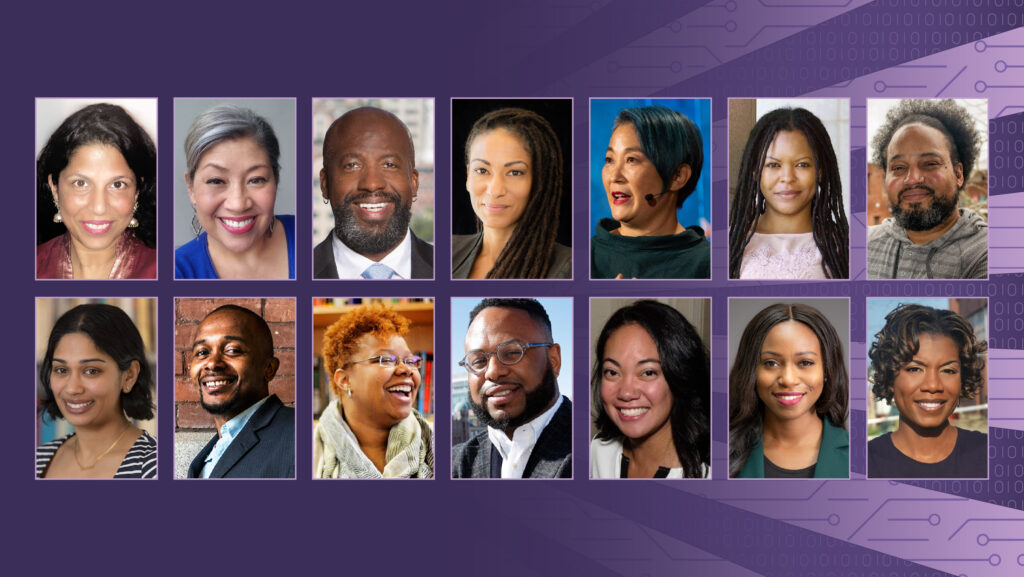
In November, NYU media professor Charlton McIlwain (opens in new tab) joined fellow scholars Safiya Noble, Ruha Benjamin, and André Brock for a virtual discussion on anti-Blackness and technology hosted by the University of California Santa Barbara. The conversation was an engaging one, and McIlwain distinctly recalls the last question of the event: what is your vision for the future in terms of race and technology?
Years earlier, McIlwain, Noble, Brock, and others had helped move race and technology from a niche field into a more formalized, impactful area of study by bringing scholars in the area together with the founding of the Center for Critical Race and Digital Studies (opens in new tab), a research and policy institute that investigates “how race, ethnicity and identity shape and are shaped by the design, deployment and use of digital technology.” Since its creation, the center had faced these questions of how race and technology affect one another and what creating a more equitable sociotechnical future will entail.
“That was a moment where we all started to think and articulate in broad strokes what needed to be and what we wanted to see happen in terms of centralizing race in the study of technology,” McIlwain says of the UCSB panel. “And much of it had to do with the expansion of a field that was connected in and through every part of research, [the] higher education landscape, both within the academy but also in private companies, in policy arenas, and so forth.”
Shortly after the UCSB discussion, Microsoft Senior Principal Research Manager Nancy Baym, who had attended the talk, reached out to McIlwain and others in the field. An expert in internet studies, she had long been interested in race and technology and believed there was immense value in engaging with this field not only individually but as an industry, and she wanted to help facilitate that engagement. With an organizing committee that included McIlwain and Baym, Microsoft Research launched Race and Technology: A Research Lecture Series in May 2021.
With the other members of the committee—Senior Principal Research Manager Hanna Wallach (opens in new tab), Chief of Staff for the Microsoft CMO Chris Morris (opens in new tab), Community Engagement Program Manager Eleanor Buxton (opens in new tab), and Senior Manager Community Engagement and Partnerships Jessica Mastronardi (opens in new tab)—McIlwain and Baym identified leading scholars representing a breadth of topics at the intersection of race and technology. The result is a free and public series of 14 monthly lectures covering a variety of domains, such as labor, public health, genomics, digital media, gaming, and software and computer science. Baym describes the series—which was designed to provide a foundational understanding to those new to the field and fresh insights to those with experience in the subject—the “best introductory graduate seminar or senior level course you could have.”
“It’s a field that just has so much to teach technology companies,” she says.
- MEET THE SPEAKERS AND REGISTER Race and Technology: A Research Lecture Series
Harms at the intersection of race and technology
One of the goals of the lecture series is to expose more people to the field and its expansive reach. For Wallach, part of the purpose can be stated even more simply than that.
“I want people to know that there is a relationship between race and technology,” says Wallach. “I think a lot of people, especially people in the tech industry, just don’t spend a huge amount of time thinking about race.”
In studying fairness-related harms in machine learning systems, her research area, Wallach frequently encounters computer scientists who are unaware until after they’ve developed a system that it’s harmful. In the last several years, researchers have shown that commercial gender classification systems incorrectly classify women with darker skin at a significantly higher rate than men with lighter skin (opens in new tab)—as much as 34 percent compared with less than 1 percent—and found that a popular algorithm used to help allocate treatment of complicated medical conditions underestimates the severity of illness in Black patients, leading to insufficient care (opens in new tab). Whether intentions were good matters little when the livelihood and well-being of people are in jeopardy.
“When we dig into these harms, we often find that the people who are most harmed by them share specific racial identities and that the harms that are taking place are reinforcing and increasing existing societal injustices that affect those groups,” says Wallach.
Although it’s important to address how technology is inadvertently unfair, it’s equally important to identify and acknowledge the intentionality and historical context that have resulted in an infrastructure that McIlwain describes as producing not just unfair technologies but anti-Black, anti-Asian, and anti-Indigenous technology in terms of benefits and harms.
For McIlwain, the race and media scholar and technology historian, the underpinnings of that infrastructure came into sharp focus when researching his 2020 book (opens in new tab)Black Software: The Internet and Racial Justice, from the AfroNet to Black Lives Matter (opens in new tab). Investigating how technology supported the rise of the Black Lives Matter movement sent McIlwain on a historical journey that revealed a confluence of the civil rights movement and computing revolution of the 1960s that was unfamiliar to him. The book chronicles a complex relationship that has yielded a set of technologies deployed by others to contain and curtail Black communities’ cultural, economic, and political power. However, it also tells the stories of Black entrepreneurs, activists, and others committed to community uplift who have seized and innovated those same technologies to elevate their identities and fight for racial justice.
In explaining just how deeply intertwined race and technology are, McIlwain recalls coming across a 2018 investigative report from The Intercept (opens in new tab) about how the New York City Police Department, for at least the previous five or six years, had been allowing IBM to access video footage of the city in developing surveillance technology that began with object detection and progressed to allow for the isolation of people by physical characteristics—including skin color. From his own work, McIlwain knew five or six years was a gross understatement.
“It was a 50-year history of the relationship between not just policing generally but the NYPD and IBM very specifically, since the mid-1960s, to build that infrastructure of surveillance technologies—of predictive policing technologies—that have so devastated Black and Brown communities,” he says.
Spotlight: Event
Microsoft at CVPR 2024
Microsoft is a proud sponsor and active participant of CVPR 2024, which focuses on advancements in computer vision and pattern recognition.
The tools to challenge the status quo
The Race and Technology lecture series organizing committee hopes that the events will begin to equip people with conceptual tools to better understand the race-technology relationship and challenge the choices that determine technology today, including those informed, deliberate efforts to create technology that maintains and exacerbates disparity.
“If we can start at least having this conversation, maybe people can start intervening earlier in the process of developing technologies,” says Baym. “They’ll have the language to do it; they’ll have the lenses to see it and to explain.”
Contributing appropriate language to help people think about and discuss race and technology is challenging itself. In deciding what to call the series, the organizing committee grappled with using the term “race,” as they didn’t want to legitimize “race” as more than the social construct it is (opens in new tab). But after discussion among themselves and with other scholars in the field, they decided to proceed with “race and technology,” as “race” is a concept that has force in the world—it’s a powerful categorization system used to sort people from birth—despite its lack of biological standing, explains Baym.
Additionally, avoiding “race” or not calling out “racist” technology where it exists doesn’t advance the conversation in a way that gets at the issue.
“We’ve talked about what is sort of racist technology as biased technology and then have started to build a nomenclature and concept and ways of responding to bias, or debiasing technologies, or debiasing data, in some way that still doesn’t really address, engage, much less help to shift what is a real problem, which is not so much just about bias but about race itself,” says McIlwain.
Empowerment at the intersection of race and technology
While the lectures position people to reflect on the harms created by technology against already marginalized groups, they also demonstrate how technology has been used by these same groups to celebrate and elevate their identities, beliefs, and lived experiences.
“As we’re asking how to change from creating technologies that harm, we’re also thinking about how to create technologies that bring pleasure and create joy and allow people to express themselves and connect with one another on the terms of their own cultural convictions,” says Baym.
Baym points to the work of André Brock (opens in new tab), November’s scheduled speaker, as an example. In his research, the media studies professor explores the notion of joy, explaining in a 2017 talk at Arizona State University (opens in new tab) that a life motivated purely by resistance to oppression and devoid of “moments where we are allowed to dream, to dance, to cry, or to feel joy” is incomplete. He has demonstrated how Twitter is an outlet for that and argues that the playfulness of Black Twitter serves as a fuel for social movements like Black Lives Matter, as fuel for “dealing with the un-fun parts of life.” It’s an area he explores more deeply in his 2020 award-winning book Distributed Blackness: African American Cybercultures (opens in new tab).
“André’s work is a great way to think about spaces like Twitter or others where Black imagination, Black futures, Black joy become the normative ground on which technology then develops,” says McIlwain.
It’s work like Brock’s and the work of other scholars that inspire the technological future Baym and McIlwain envision—for Baym, one in which technology isn’t limiting but rather a resource communities adopt and adapt to achieve what they want, and for McIlwain, a world in which whiteness isn’t the baseline for developing technology.
“Can I imagine a tech future that revolves around me and people like me?” McIlwain asks in considering the future. “And I think that’s where we want to get to, where Black folks, Indigenous folks, Latinx folks, everyone can see that it’s normative to think about, here’s something that works for me and us and people like us. And I think that’s just a radically different way of thinking about how we think about technology conceptually and certainly as we build and put it into place.”
Pursuing change
There is much work that needs to be done before that future can be reached, including continuing to support the elevation of the field of race and technology from afterthought to core component of discussions happening across academia, technology, biomedicine, public policy, computer science—all disciplines.
“It really is, you know, expanding and getting to a point where these ideas, this field, the people that are part of and leading it and working in it are part of the fabric of each of these domains,” says McIlwain. “It’s to say, what if we made race, ethnicity, all the things that are bound up with it part of the everyday conversation?”
McIlwain and Baym expect those who attend the series to have a range of experiences as they interact with the material—some of the topics will resonate while others may “blow their mind.” And there is potential for some discomfort as people face realities that may have been hidden to them before, but they encourage attendees to join the discussion with humility and an open mind.
“I think a lot of people will come away excited about a field and a set of topics that are ripe for new study, new engagement, across so many different domains,” says McIlwain, adding that “we have the power to do what it is we want to envision.”
To learn more about the series, as well as to register, visit the Race and Technology: A Research Lecture Series home page. To catch up on previous lectures and access additional learning materials associated with each lecture, click on the “Past Speakers” tab from the home page.





